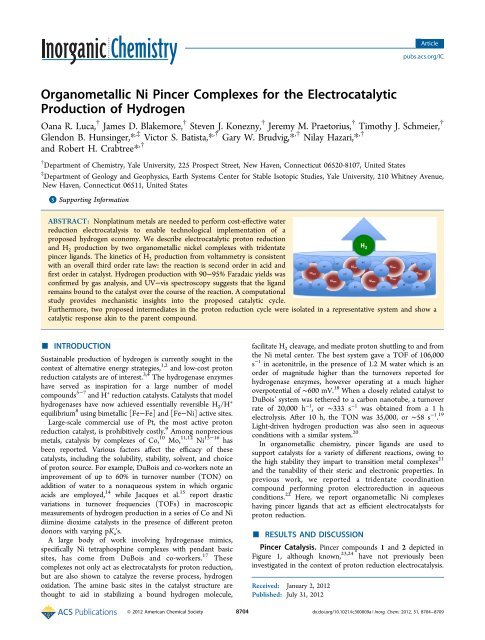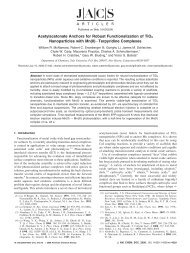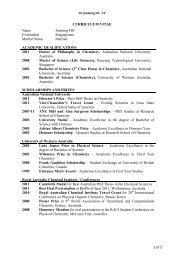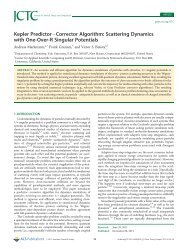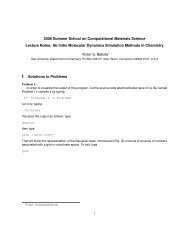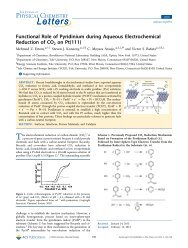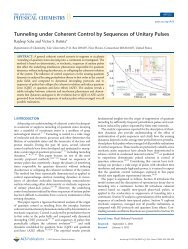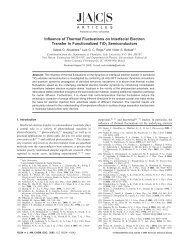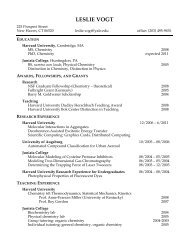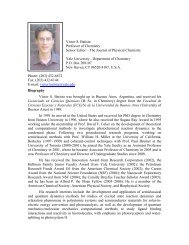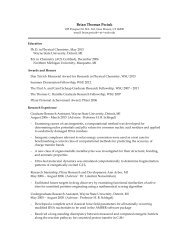Organometallic Ni Pincer Complexes for the Electrocatalytic ...
Organometallic Ni Pincer Complexes for the Electrocatalytic ...
Organometallic Ni Pincer Complexes for the Electrocatalytic ...
You also want an ePaper? Increase the reach of your titles
YUMPU automatically turns print PDFs into web optimized ePapers that Google loves.
Article<br />
pubs.acs.org/IC<br />
<strong>Organometallic</strong> <strong>Ni</strong> <strong>Pincer</strong> <strong>Complexes</strong> <strong>for</strong> <strong>the</strong> <strong>Electrocatalytic</strong><br />
Production of Hydrogen<br />
Oana R. Luca, † James D. Blakemore, † Steven J. Konezny, † Jeremy M. Praetorius, † Timothy J. Schmeier, †<br />
Glendon B. Hunsinger,* ,‡ Victor S. Batista,* ,† Gary W. Brudvig,* ,† <strong>Ni</strong>lay Hazari,* ,†<br />
and Robert H. Crabtree* ,†<br />
† Department of Chemistry, Yale University, 225 Prospect Street, New Haven, Connecticut 06520-8107, United States<br />
‡ Department of Geology and Geophysics, Earth Systems Center <strong>for</strong> Stable Isotopic Studies, Yale University, 210 Whitney Avenue,<br />
New Haven, Connecticut 06511, United States<br />
*S Supporting In<strong>for</strong>mation<br />
ABSTRACT: Nonplatinum metals are needed to per<strong>for</strong>m cost-effective water<br />
reduction electrocatalysis to enable technological implementation of a<br />
proposed hydrogen economy. We describe electrocatalytic proton reduction<br />
and H 2 production by two organometallic nickel complexes with tridentate<br />
pincer ligands. The kinetics of H 2 production from voltammetry is consistent<br />
with an overall third order rate law: <strong>the</strong> reaction is second order in acid and<br />
first order in catalyst. Hydrogen production with 90−95% Faradaic yields was<br />
confirmed by gas analysis, and UV−vis spectroscopy suggests that <strong>the</strong> ligand<br />
remains bound to <strong>the</strong> catalyst over <strong>the</strong> course of <strong>the</strong> reaction. A computational<br />
study provides mechanistic insights into <strong>the</strong> proposed catalytic cycle.<br />
Fur<strong>the</strong>rmore, two proposed intermediates in <strong>the</strong> proton reduction cycle were isolated in a representative system and show a<br />
catalytic response akin to <strong>the</strong> parent compound.<br />
■ INTRODUCTION<br />
Sustainable production of hydrogen is currently sought in <strong>the</strong><br />
context of alternative energy strategies, 1,2 and low-cost proton<br />
reduction catalysts are of interest. 3,4 The hydrogenase enzymes<br />
have served as inspiration <strong>for</strong> a large number of model<br />
compounds 5−7 and H + reduction catalysts. Catalysts that model<br />
hydrogenases have now achieved essentially reversible H 2 /H +<br />
equilibrium 8 using bimetallic [Fe−Fe] and [Fe−<strong>Ni</strong>] active sites.<br />
Large-scale commercial use of Pt, <strong>the</strong> most active proton<br />
reduction catalyst, is prohibitively costly. 9 Among nonprecious<br />
metals, catalysis by complexes of Co, 10 Mo, 11,12 <strong>Ni</strong> 13−16 has<br />
been reported. Various factors affect <strong>the</strong> efficacy of <strong>the</strong>se<br />
catalysts, including <strong>the</strong> solubility, stability, solvent, and choice<br />
of proton source. For example, DuBois and co-workers note an<br />
improvement of up to 60% in turnover number (TON) on<br />
addition of water to a nonaqueous system in which organic<br />
acids are employed, 14 while Jacques et al. 15 report drastic<br />
variations in turnover frequencies (TOFs) in macroscopic<br />
measurements of hydrogen production in a series of Co and <strong>Ni</strong><br />
diimine dioxime catalysts in <strong>the</strong> presence of different proton<br />
donors with varying pK a 's.<br />
A large body of work involving hydrogenase mimics,<br />
specifically <strong>Ni</strong> tetraphosphine complexes with pendant basic<br />
sites, has come from DuBois and co-workers. 17 These<br />
complexes not only act as electrocatalysts <strong>for</strong> proton reduction,<br />
but are also shown to catalyze <strong>the</strong> reverse process, hydrogen<br />
oxidation. The amine basic sites in <strong>the</strong> catalyst structure are<br />
thought to aid in stabilizing a bound hydrogen molecule,<br />
facilitate H 2 cleavage, and mediate proton shuttling to and from<br />
<strong>the</strong> <strong>Ni</strong> metal center. The best system gave a TOF of 106,000<br />
s −1 in acetonitrile, in <strong>the</strong> presence of 1.2 M water which is an<br />
order of magnitude higher than <strong>the</strong> turnovers reported <strong>for</strong><br />
hydrogenase enzymes, however operating at a much higher<br />
overpotential of ∼600 mV. 18 When a closely related catalyst to<br />
DuBois’ system was te<strong>the</strong>red to a carbon nanotube, a turnover<br />
rate of 20,000 h −1 , or ∼333 s −1 was obtained from a 1 h<br />
electrolysis. After 10 h, <strong>the</strong> TON was 35,000, or ∼58 s −1 . 19<br />
Light-driven hydrogen production was also seen in aqueous<br />
conditions with a similar system. 20<br />
In organometallic chemistry, pincer ligands are used to<br />
support catalysts <strong>for</strong> a variety of different reactions, owing to<br />
<strong>the</strong> high stability <strong>the</strong>y impart to transition metal complexes 21<br />
and <strong>the</strong> tunability of <strong>the</strong>ir steric and electronic properties. In<br />
previous work, we reported a tridentate coordination<br />
compound per<strong>for</strong>ming proton electroreduction in aqueous<br />
conditions. 22 Here, we report organometallic <strong>Ni</strong> complexes<br />
having pincer ligands that act as efficient electrocatalysts <strong>for</strong><br />
proton reduction.<br />
■ RESULTS AND DISCUSSION<br />
<strong>Pincer</strong> Catalysis. <strong>Pincer</strong> compounds 1 and 2 depicted in<br />
Figure 1, although known, 23,24 have not previously been<br />
investigated in <strong>the</strong> context of proton reduction electrocatalysis.<br />
Received: January 2, 2012<br />
Published: July 31, 2012<br />
© 2012 American Chemical Society 8704 dx.doi.org/10.1021/ic300009a | Inorg. Chem. 2012, 51, 8704−8709
Inorganic Chemistry<br />
Article<br />
Figure 1. <strong>Ni</strong>ckel complexes used in <strong>the</strong> study of proton-reduction electrocatalysis. 23,24<br />
Their electrochemistry has now been studied in a standard 0.1<br />
M acetonitrile/supporting electrolyte solution to determine<br />
<strong>the</strong>ir reduction potentials and establish any correlation between<br />
<strong>the</strong>ir catalytic activity and <strong>the</strong> ligand donor power (Figure 2).<br />
negative overpotential at 1.5 mA cm −2 <strong>for</strong> 2 (−0.370 V), than<br />
<strong>for</strong> 1 (−0.345 V).<br />
Table 1. Relative Rates of Proton Reduction in a 0.1 M<br />
NBu 4 BF 4 Acetonitrile Solution and Overpotentials of<br />
Catalysts 1 and 2 at 1.5 mA cm −2<br />
catalyst k (M −2 s −1 )<br />
TOF<br />
(s −1 )<br />
rate overpotential b at faradaic<br />
(M s −1 ) a 1.5 mA cm −2 yield c<br />
1 0.55 × 10 4 ± 54.6 0.275 −0.370 V 90% ±<br />
0.32 × 10 3 3%<br />
2 2.9 × 10 4 ± 209 1.045 −0.345 V 95% ±<br />
1.7 × 10 3 4%<br />
a Calculated <strong>for</strong> 0.1 M H + , 5 mM catalyst, using <strong>the</strong> method described<br />
by DuBois et al. 26 b Value determined from plots of current density vs<br />
applied potential constructed from chronoamperograms (dwell time:<br />
60 s) at progressively more negative potentials corrected <strong>for</strong> [H + ]=<br />
0.037 M (<strong>the</strong> pH = −log[H + ] = 1.42, E o ′ = −59 mV/pH*1.42 = −84<br />
mV vs NHE). The working electrode was a 3 mm diameter glassy<br />
carbon disk. Measurements were per<strong>for</strong>med with magnetic stirring,<br />
using 5.2 mL acetonitrile solutions containing 200 μL of 1 M aqueous<br />
HCl at catalyst concentrations of 0.2 mM with Ar purge. c From bulk<br />
electrolyses at −0.6 V vs NHE, (details in <strong>the</strong> Experimental Section<br />
and Supporting In<strong>for</strong>mation).<br />
Figure 2. Solid lines: Nonaqueous electrochemistry of compounds 1<br />
and 2: 2 mM <strong>Ni</strong> complex in a 0.1 M NBu 4 BF 4 acetonitrile solution at a<br />
glassy carbon electrode (100 mV/s) top to bottom: blue 1; purple 2. See<br />
Supporting In<strong>for</strong>mation <strong>for</strong> CVs of complexes 1 and 2 at different scan<br />
rates. Dashed lines: 2 mM solutions of complexes 1 and 2 in a 0.1 M<br />
NBu 4 BF 4 acetonitrile solution with 20 μL 1 M HCl at 100 mV/s.<br />
Our results confirm <strong>the</strong> expectation that a more strongly donor<br />
ligand framework stabilizes <strong>the</strong> higher oxidation state and<br />
makes metal reduction more difficult (See Figure 2 and<br />
Supporting In<strong>for</strong>mation <strong>for</strong> details).<br />
<strong>Complexes</strong> 1 and 2 show similar electrochemical behavior.<br />
They both show a single reduction wave which we assign to a<br />
<strong>Ni</strong> II /<strong>Ni</strong> I couple. Complex 1 is more easily reduced than<br />
complex 2 which is consistent with <strong>the</strong> more donating<br />
framework of <strong>the</strong> PCP ligand in complex 2. 25<br />
Incremental addition of aliquots of a 1 M HCl solution to<br />
complexes 1 and 2 led to a progressive increase in <strong>the</strong> current<br />
observed by voltammetry in this nickel pincer series (see<br />
Supporting In<strong>for</strong>mation). Figure 2 shows comparative cyclic<br />
voltammograms (CVs) of <strong>the</strong> pincer complexes in <strong>the</strong> presence<br />
of 20 μL of 1 M HCl. Compound 1 showed an irreversible<br />
wave with a less negative onset potential than <strong>the</strong> one observed<br />
<strong>for</strong> 2 under <strong>the</strong> same conditions. As expected, increasingly<br />
donor ligands appear to provide more negative onset potentials.<br />
Both waves are consistent with catalytic H 2 production,<br />
although <strong>the</strong> onset of catalysis is at much higher potentials<br />
than <strong>the</strong> reduction potentials of 1 and 2 in <strong>the</strong> absence of acid,<br />
an explanation <strong>for</strong> which is presented later. Plots of current<br />
density vs applied potential were constructed <strong>for</strong> catalysts 1 and<br />
2 (Table 1 and Supporting In<strong>for</strong>mation, S2) and show a more<br />
The rates of H 2 production were measured from<br />
voltammetry in acetonitrile (Table 1) using <strong>the</strong> method of<br />
DuBois and co-workers 14 described in detail in <strong>the</strong> Supporting<br />
In<strong>for</strong>mation. Our data are consistent with an overall third order<br />
rate law: <strong>the</strong> reaction is second order in acid and first order in<br />
catalyst. Catalyst 2 has a TOF of 209 s −1 under <strong>the</strong> reaction<br />
conditions, which is faster than catalyst 1 (54.6 s −1 ). The<br />
Faradaic yield of H 2 production by 1 and 2, measured using<br />
bulk electrolysis followed by quantitative mass spectrometry<br />
detection of H 2 , is excellent, with approximately 90% yield<br />
observed in both cases. We believe that our catalysts are<br />
operationally homogeneous as UV−vis spectra of <strong>the</strong> catholyte<br />
be<strong>for</strong>e and after electrolyses show that <strong>the</strong> characteristic<br />
spectroscopic features of <strong>the</strong> catalysts are maintained,<br />
suggesting that significant decomposition is not occurring.<br />
Fur<strong>the</strong>rmore, when <strong>the</strong> electrode was removed after<br />
electrolyses, rinsed, and immersed in fresh electrolyte, no<br />
catalytic response was observed. This suggests an insoluble<br />
heterogeneous nickel catalyst is not being deposited on <strong>the</strong><br />
electrode. The difference in catalytic rates based on <strong>the</strong> ligand is<br />
also consistent with a homogeneous system. Overall, our<br />
complexes appear to be slower catalysts in acetonitrile than<br />
DuBois’ <strong>Ni</strong> tetraphosphine systems, 14,17,18 but <strong>the</strong>y operate at<br />
similar overpotentials. However, direct comparison is complicated<br />
because of differences in <strong>the</strong> exact experimental<br />
conditions.<br />
Proposed Catalytic Cycle and Mechanistic Experiments.<br />
Although <strong>the</strong> mechanism <strong>for</strong> proton reduction using<br />
tetraphosphine systems such as those described by DuBois is<br />
relatively well understood, 17 we were interested in comparing it<br />
to our PCP supported systems. As in previous studies, we<br />
8705<br />
dx.doi.org/10.1021/ic300009a | Inorg. Chem. 2012, 51, 8704−8709
Inorganic Chemistry<br />
applied density functional <strong>the</strong>ory (DFT) with <strong>the</strong> B3LYP<br />
functional to characterize <strong>the</strong> structural and spin/electronic<br />
properties of <strong>the</strong> reaction intermediates and per<strong>for</strong>m free<br />
energy calculations. 22,27 Our calculated cycle <strong>for</strong> proton<br />
reduction catalyzed by 2 can be observed in Scheme 1, with<br />
Scheme 1. Proposed Catalytic Cycle of Proton Reduction<br />
Supported by DFT Calculations at <strong>the</strong> B3LYP/LANL2DZ/<br />
cc-pVTZ Level of Theory Using [2-MeCN] + Formed after<br />
Loss of Cl − in MeCN<br />
Article<br />
undergoes an initial ligand centered reduction. 22 It indicates<br />
that a redox active ligand is not required <strong>for</strong> pincer complexes<br />
to be active <strong>for</strong> proton reduction. To complete <strong>the</strong> cycle, <strong>the</strong><br />
<strong>Ni</strong> III intermediate [2-H] + is fur<strong>the</strong>r reduced by one electron to<br />
give <strong>the</strong> square planar <strong>Ni</strong> II hydride [2-H] 0 which <strong>the</strong>n<br />
undergoes protonation to give <strong>the</strong> dihydrogen complex [2-<br />
H 2 ] + , followed by loss of H 2 to regenerate [2-MeCN] + . The<br />
third order rate law experimentally determined <strong>for</strong> catalysts 1<br />
and 2 suggests that <strong>the</strong> turnover limiting step in our catalytic<br />
cycles involve protonation of <strong>the</strong> <strong>Ni</strong>−H intermediate [2-H] 0 to<br />
[2-H] + . Although we cannot exclude <strong>the</strong> limiting step being<br />
loss of H 2 , relative energies indicate that this should be a<br />
spontaneous process <strong>for</strong> 2.<br />
Our mechanism <strong>for</strong> H 2 production is analogous to DuBois’<br />
system; 17 however, <strong>the</strong> PCP framework that supports <strong>the</strong><br />
catalytically active compound 2 provides a tractable representative<br />
system <strong>for</strong> <strong>the</strong> isolation of possible intermediates. For <strong>the</strong><br />
purposes of probing this hypo<strong>the</strong>sis, we independently<br />
prepared [2-MeCN] + via chloride abstraction from (PCP)<strong>Ni</strong>Cl<br />
(2). The hydride complex 2-H was also syn<strong>the</strong>tically accessible<br />
by literature methods. 24<br />
The redox behavior of complex 2-H shown in Figure 3 was<br />
followed by cyclic voltammetry using 0.1 M NBu 4 BF 4 and 2<br />
Table 2. Comparison of Relative Free Energies in Solution<br />
ΔG(MeCN) from DFT Calculations of Intermediates in<br />
Proton Reduction Using 2<br />
compound<br />
ΔG(MeCN)<br />
(kcal mol −1 )<br />
ΔG(MeCN) vs NHE a<br />
(eV)<br />
[2-MeCN] + 0 0<br />
[2-MeCN] 0 −64.8 1.57<br />
[2-H] + −72.0 1.26<br />
[2-H] 0 −177.6 1.16<br />
[2-H 2 ] + −192.7 0.51<br />
[2-MeCN] + +H 2 − 2H + − −204.4 0<br />
2e −<br />
a Assumes a normal hydrogen electrode potential of 4.48 V in MeCN.<br />
energies of <strong>the</strong> intermediates provided in Table 2. We believe<br />
that (PCP)<strong>Ni</strong>Cl (2) serves as a precatalyst and <strong>the</strong> active<br />
species is <strong>the</strong> solvento complex [2-MeCN] + . Subsequently, one<br />
electron reduction of [2-MeCN] + generates <strong>the</strong> <strong>Ni</strong> I species [2-<br />
MeCN] 0 (Scheme 1), which is consistent with our assignment<br />
of <strong>the</strong> first reduction in <strong>the</strong> CV of 2 to <strong>the</strong> <strong>Ni</strong> II /<strong>Ni</strong> I couple.<br />
Sequential MeCN ligand loss (−4.8 kcal mol −1 ) followed by<br />
protonation (−2.3 kcal mol −1 )of[2-MeCN] 0 to <strong>for</strong>m <strong>the</strong> <strong>Ni</strong> III<br />
hydride [2-H] + is downhill in energy, thus indicating a<br />
favorable process. The calculated pK a of [2-H] + is 1.7, similar<br />
to <strong>the</strong> pK a of 1.8 measured <strong>for</strong> [<strong>Ni</strong>(cyclam)(H)] 2+ (cyclam =<br />
1,4,8,1 L-tetraazacyclotetradecane) in aqueous solution. 28 The<br />
fact that <strong>the</strong>se <strong>Ni</strong> hydrides with N-based ligands are less acidic<br />
than <strong>Ni</strong> hydrides with P-based ligands 29 is consistent with pK a<br />
trends observed in o<strong>the</strong>r metal hydrides. 30 Analysis of <strong>the</strong> spin<br />
density on [2-H] + confirms that it is a <strong>Ni</strong> III species with no<br />
significant delocalization of <strong>the</strong> spin onto <strong>the</strong> ligand framework.<br />
This stands in contrast to our recent report of a <strong>Ni</strong> proton<br />
reduction catalyst supported by an NNN pincer ligand, which<br />
Figure 3. Blue: CV of 2 mM 2-H in a 0.1 M NBu 4 BF 4 acetonitrile<br />
solution under air/water free conditions 100 mV/s. Gray: CVs of<br />
parent compound 2 (top gray CV completely silent in <strong>the</strong> scanned<br />
region) involved in proton reduction with 4 × 10 μL increments of 1<br />
M HCl.<br />
mM catalyst precursor solution in a Schlenk cell under<br />
rigorously anhydrous conditions. The change from <strong>the</strong> halide<br />
in 2 to <strong>the</strong> much softer H − ligation in 2-H causes a dramatic<br />
shift of <strong>the</strong> <strong>Ni</strong> II /<strong>Ni</strong> I couple by almost 1 V in <strong>the</strong> positive<br />
direction to −0.2 V vs NHE. This wave also coincides with <strong>the</strong><br />
onset of proton reduction catalysis in <strong>the</strong> parent halide 2, as<br />
seen in Figure 2. This observation is consistent with 2-H being<br />
a key intermediate in <strong>the</strong> overall catalytic reaction. Upon<br />
incremental addition of 10 μL of HCl to 2-H (see Supporting<br />
In<strong>for</strong>mation), bubbles are immediately observed followed by a<br />
steadily increasing current response analogous to <strong>the</strong> chloride<br />
compound under <strong>the</strong> same conditions. We, <strong>the</strong>re<strong>for</strong>e, assign <strong>the</strong><br />
observed electrochemistry to <strong>the</strong> [2-H] + /[2-H] 0 step (Scheme<br />
1) and its participation in <strong>the</strong> catalytic cycle.<br />
8706<br />
dx.doi.org/10.1021/ic300009a | Inorg. Chem. 2012, 51, 8704−8709
Inorganic Chemistry<br />
Article<br />
The protonation of 2-H with 1 equiv of HBF 4 in acetonitrile<br />
results in <strong>the</strong> clean <strong>for</strong>mation of <strong>the</strong> solvento cation [2-<br />
MeCN] + (eq 1). This was confirmed by comparison of <strong>the</strong> 1 H<br />
NMR spectrum with an au<strong>the</strong>ntic sample of [2-MeCN] +<br />
prepared through <strong>the</strong> abstraction of Cl − from 2. When 2-H<br />
was protonated in a J. Young NMR tube, H 2 was detected by<br />
1 H NMR spectroscopy. This is consistent with our proposed<br />
mechanism involving protonation of <strong>the</strong> hydride, to generate a<br />
short-lived dihydrogen complex [2-H 2 ] + in Scheme 1, followed<br />
by coordination of solvent to close <strong>the</strong> cycle. A molecular<br />
hydrogen complex is a probable intermediate in <strong>the</strong> conversion<br />
of 2-H to [2-MeCN] + but is presumably too unstable to<br />
observe spectroscopically in acetonitrile in <strong>the</strong> time scale of <strong>the</strong><br />
experiment.<br />
In <strong>the</strong> absence of protons, [2-MeCN] + shows an irreversible<br />
<strong>Ni</strong> II /<strong>Ni</strong> I wave at a potential intermediate between those of 2<br />
and 2-H (Supporting In<strong>for</strong>mation, Figure S1−3) which we<br />
believe corresponds to <strong>the</strong> [2-MeCN] + /[2-MeCN] 0 in <strong>the</strong><br />
catalytic cycle depicted in Scheme 1. The irreversibility and<br />
magnitude of <strong>the</strong> wave is caused by <strong>the</strong> inability of <strong>the</strong><br />
acetonitrile ligand to stabilize <strong>the</strong> <strong>Ni</strong> I center being <strong>for</strong>med (See<br />
Supporting In<strong>for</strong>mation <strong>for</strong> CVs at different scan rates). The<br />
reduction of <strong>the</strong> cationic [2-MeCN] + may also be coupled to a<br />
chemical process at <strong>the</strong> electrode surface. It has previously been<br />
observed that changes in ligation at <strong>the</strong> metal center alter <strong>the</strong><br />
observed electrochemical behavior. 31<br />
In acidic conditions, [2-MeCN] + shows an increasing<br />
cathodic current response akin to 2-H and 2 (Supporting<br />
In<strong>for</strong>mation, Figure S1−3). The onset of <strong>the</strong> catalytic wave is in<br />
<strong>the</strong> same region as <strong>the</strong> <strong>Ni</strong> II /<strong>Ni</strong> I wave exhibited by 2-H,<br />
supporting our hypo<strong>the</strong>sis that <strong>the</strong> solvento complex is<br />
involved in <strong>the</strong> catalytic cycle. In general, <strong>the</strong> onset of a<br />
catalytic process is often associated with a distinct reversible<br />
wave corresponding to a redox change at a metal center. In <strong>the</strong><br />
present case, we believe that <strong>the</strong> observed electrocatalytic<br />
response is a result of reduction of an in situ generated pincer-<br />
<strong>Ni</strong>-H species in <strong>the</strong> presence of protons. To confirm our<br />
hypo<strong>the</strong>sis, we observe that <strong>the</strong> onset of proton reduction<br />
electrocatalysis <strong>for</strong> 2, 2-H, and [2-MeCN] + occurs at <strong>the</strong> same<br />
potential (Figure 4 and Supporting In<strong>for</strong>mation, Figure S1−3)<br />
under similar conditions.<br />
■ CONCLUSIONS<br />
Two organometallic <strong>Ni</strong> II pincer complexes are active catalysts<br />
<strong>for</strong> electrochemical proton reduction. Bulk electrolysis experiments<br />
followed by macroscopic determination of <strong>the</strong> quantity<br />
of H 2 produced demonstrated good Faradaic yields (90%−<br />
95%). Two of <strong>the</strong> possible intermediate species were isolated<br />
and shown to be catalytically active using <strong>the</strong> PCP ligand<br />
framework. Computation provides corroboration <strong>for</strong> <strong>the</strong><br />
proposed catalytic cycle. Fur<strong>the</strong>r tuning of <strong>the</strong> ligand will be<br />
explored to look <strong>for</strong> even more active catalysts that operate at<br />
lower overpotentials.<br />
Figure 4. Overlay of CVs of acetonitrile (0.1 M NBu 4 BF 4 ) solutions 2<br />
mM 2 with 10 (solid gray) and 20 μL of 0.1 M aqueous HCl (dotted<br />
gray), 2-H (solid navy), 2-H with 10 μL of 1 M aqueous HCl (dash-dot<br />
navy), and 2-H with 20 μL of 1 M aqueous HCl (dash-dot navy).<br />
■ EXPERIMENTAL SECTION<br />
General Methods. All reagents were received from commercial<br />
sources and used without fur<strong>the</strong>r purification unless o<strong>the</strong>rwise<br />
specified. Solvents were dried by passage through a column of<br />
activated alumina followed by storage under dinitrogen. NMR spectra<br />
were recorded at room temperature on Bruker AMX-400 or 500 MHz<br />
spectrometers unless o<strong>the</strong>rwise specified. Chemical shifts are reported<br />
with respect to residual internal protio solvent <strong>for</strong> 1 H and 13 C{ 1 H}<br />
NMR spectra and to an external standard <strong>for</strong> 31 P{ 1 H} spectra (85%<br />
H 3 PO 4 at 0.0 ppm). Literature procedures were utilized to syn<strong>the</strong>size<br />
compounds 1, 2, and 2-H. 23−25<br />
Electrochemical Experiments, Bulk Electrolyses, and Gas<br />
Analysis. CVs in acetonitrile were collected on glassy carbon<br />
electrodes (3 mm diameter from Bioanalytical Systems) with a<br />
platinum wire counter electrode and a silver wire reference electrode<br />
in a BASI Double Junction Reference Electrode Setup MF-2030<br />
(referenced to NHE with ferrocene as external standard E 1/2 = 690 mV<br />
vs NHE). An alternate ferrocene reference scale is provided <strong>for</strong> all<br />
CVs. Measurements were per<strong>for</strong>med in 0.1 M NBu 4 BF 4 solutions at 2<br />
mM concentration of <strong>the</strong> respective complexes. CVs were recorded<br />
after additions of 4 × 10 μL of 1 M HCl via volumetric syringe (10 μL<br />
of 1 M HCl corresponds to [H + ] = 10 mM, 20 μL [H + ] = 20 mM, 30<br />
μL [H + ] = 30 mM and 40 μL corresponds to [H + ] = 40 mM,<br />
respectively). CV measurements of 2-H were per<strong>for</strong>med under Argon<br />
in a custom-built air sensitive voltammetry cell equipped with a<br />
septum injection port. All o<strong>the</strong>r CVs were recorded after rigorous<br />
exclusion of air via Argon purge. Data workup was per<strong>for</strong>med on<br />
OriginPro v8.0988 and AfterMath Data Organizer Version 1.2.3383.<br />
Plots of current density vs applied potential were constructured<br />
from chronoamperometry experiments (dwell time: 60 s) at potentials<br />
lower than 0 V (vs NHE) at a glassy carbon electrode in a singlechamber,<br />
three-electrode configuration. The experiments were<br />
per<strong>for</strong>med in 5.2 mL of 0.1 M NBu 4 BF 4 acetonitrile solutions<br />
containing 0.2 mM catalyst and 200 μL of a 1 M aqueous HCl<br />
solution. Vigorous magnetic stirring was used to avoid diffusion<br />
limitations from concentration gradients at <strong>the</strong> working electrode.<br />
The order of reaction with respect to acid was determined by<br />
analysis of CVs of 2 mM catalyst solutions with different acid<br />
concentrations. To a 0.1 M NBu 4 BF 4 acetonitrile solution containing 2<br />
mM catalyst (from <strong>the</strong> CVs of which i p was determined at different<br />
scan rates), 5 μL increments were added of an aqueous 1 M HCl<br />
solution also containing 0.1 M NBu 4 BF 4 . The voltammograms thus<br />
collected at each acid concentration <strong>for</strong> several scan rates were used to<br />
obtain catalytic currents, denoted i c . The ratio of i c /i p was plotted<br />
8707<br />
dx.doi.org/10.1021/ic300009a | Inorg. Chem. 2012, 51, 8704−8709
Inorganic Chemistry<br />
against acid concentration <strong>for</strong> <strong>the</strong> different scan rates. From <strong>the</strong><br />
approximately linear behavior at each scan rate, we conclude that our<br />
system obeys a rate law which is second order in acid. The slopes of<br />
<strong>the</strong> scan rate-dependent data were <strong>the</strong>n used to calculate <strong>the</strong> third<br />
order rate constants. Graphs and description of <strong>the</strong> methods are<br />
available in <strong>the</strong> Supporting In<strong>for</strong>mation.<br />
The order in catalyst was determined from voltammograms<br />
collected at 100 mV/s with 3.5 mL of a 0.1 M NBu 4 BF 4 acetonitrile<br />
solution with a concentration of 2.82 mM catalyst and 4 mM acid.<br />
Increments of 0.5 mL of a 0.1 M NBu 4 BF 4 acetonitrile solution were<br />
added, and <strong>the</strong> dilutions were adjusted to maintain a constant acid<br />
concentration. We assumed no significant variations in <strong>the</strong> acid<br />
concentration throughout <strong>the</strong> experiment. From each voltammogram,<br />
i c was plotted against catalyst concentration. From <strong>the</strong> linearity of <strong>the</strong><br />
resulting graph, we conclude that at reasonably low catalyst<br />
concentration first order behavior is observed. Graphs and description<br />
of <strong>the</strong> methods are available in <strong>the</strong> Supporting In<strong>for</strong>mation.<br />
Controlled potential headspace H 2 detection experiments were<br />
per<strong>for</strong>med in a custom built two cylinder 50 mL bulk electrolysis H<br />
cell anode/cathode chamber separated by a coarse frit. The working<br />
electrode was a reticulated vitreous carbon electrode from<br />
Bioanalytical Systems MF-2077 referenced vs Ag/AgCl in KCl sat .<br />
Headspace H 2 detection was per<strong>for</strong>med at <strong>the</strong> Yale Department of<br />
Geology on a calibrated mass spectrometer: dual inlet Thermo<br />
Finnegan MDT 253 and an airtight bulk electrolysis H Cell equipped<br />
with a sampling port. One milliliter volumes of gas were compressed in<br />
<strong>the</strong> bellow and <strong>the</strong>n opened to <strong>the</strong> mass spectrometer.<br />
Computational Methods. Density functional calculations were<br />
carried out using Gaussian 09. 32 Gas phase free energy changes were<br />
calculated at <strong>the</strong> B3LYP/LANL2DZ/cc-pVTZ level, using minimum<br />
energy structures obtained at <strong>the</strong> B3LYP/LANL2DZ level of <strong>the</strong>ory.<br />
Full optimization of geometry was per<strong>for</strong>med without any symmetry<br />
constraint, followed by analytical computation of <strong>the</strong> Hessian matrix to<br />
identify <strong>the</strong> nature of <strong>the</strong> located extrema as minima. The solvation<br />
free energies ΔG solv <strong>for</strong> species o<strong>the</strong>r than solvated H + were computed<br />
using <strong>the</strong> Polarizable Continuum Model as implemented in Gaussian<br />
09 based on <strong>the</strong> gas-phase geometries with dielectric constant of ε =<br />
35.7 <strong>for</strong> MeCN. The cc-pVTZ basis set was used <strong>for</strong> all atoms except<br />
<strong>Ni</strong> <strong>for</strong> which <strong>the</strong> LANL2DZ basis set was substituted. Free energies in<br />
solution were determined using <strong>the</strong> gas-phase free energies, <strong>the</strong><br />
solvation free energies, and <strong>the</strong> Born−Haber <strong>the</strong>rmodynamic<br />
cycle. 22,27 For <strong>the</strong> solvated proton, a free energy in MeCN of<br />
−266.48 kcal mol −1 was used based on an experimentally<br />
determined 33 solvation free energy of ΔG H+ solv(MeCN) = −260.20<br />
kcal mol −1 .<br />
Syn<strong>the</strong>sis and Characterization of New Compounds and<br />
Experimental Procedure. Syn<strong>the</strong>sis of [(PCP)<strong>Ni</strong>(NCCH 3 )] + [BF 4 ] − [2-<br />
MeCN] + . To (PCP)<strong>Ni</strong>Cl (2) (40 mg, 82 μmol) and AgBF 4 (16 mg, 82<br />
μmol) was added 1 mL of acetonitrile at 25 °C. The reaction was<br />
stirred overnight and <strong>the</strong>n filtered through Celite. The solvent was<br />
removed in vacuo to give [(PCP)<strong>Ni</strong>(NCCH 3 )] + [BF 4 ] − [2-MeCN] + as<br />
a yellow-orange powder (47 mg, 99% Yield). Single crystals suitable<br />
<strong>for</strong> X-ray crystallography were grown from saturated acetonitrile<br />
solutions containing [2-MeCN] + (see Supporting In<strong>for</strong>mation, S7).<br />
HR FT-ICR MS: Found (calcd <strong>for</strong> C 26 H 46 N<strong>Ni</strong>P 2 ): m/z = (M) +<br />
492.2467 (492.2459), (M-NCCH 3 ) + 451.2193 (451.2196). 1 H NMR<br />
(NCCD 3 , 500.0 MHz): δ 6.94−6.98 (3H, m, ArH), 3.32 (4H, t,<br />
PCH 2 Ar, J = 4.2 Hz), 1.37 (36H, t, PC(CH 3 ) 3 , J = 6.6 Hz). 13 C{ 1 H}<br />
NMR (NCCD 3 , 125.8 MHz): δ 154.6 (t, J = 11.4 Hz), 153.0 (t, J =<br />
13.9 Hz), 135.9 (s), 128.0 (s), 123.4 (t, J = 9.1 Hz), 35.9 (t, J = 7.6<br />
Hz), 33.4 (t, J = 13.7 Hz), 29.7 (s). 31 P-{ 1 H} NMR (NCCD 3 , 161.9<br />
MHz): 80.1 ppm.<br />
Protonation of [(PCP)<strong>Ni</strong>H] (2-H). To [(PCP)<strong>Ni</strong>H] (2-H) (3 mg,<br />
6.2 μmol) dissolved in 0.5 mL of d 3 -acetonitrile in a J. Young NMR<br />
tube was added 1 equiv of HBF 4 in 10 μL ofH 2 Oat25°C. Mixing of<br />
<strong>the</strong> two solutions occurred only after <strong>the</strong> NMR cap was replaced. 1 H<br />
NMR spectroscopy displayed a characteristic resonance <strong>for</strong> H 2 along<br />
with peaks corresponding to [(PCP)<strong>Ni</strong>(NCCH 3 )] + [BF 4 ] − [2-<br />
MeCN] + .<br />
■<br />
Article<br />
ASSOCIATED CONTENT<br />
*S Supporting In<strong>for</strong>mation<br />
Additional CVs, fur<strong>the</strong>r experimental details, details of <strong>the</strong><br />
crystal structure determination of [2-MeCN] + and xyz<br />
coordinates and energies of optimized structures. This material<br />
is ■available free of charge via <strong>the</strong> Internet at http://pubs.acs.org.<br />
AUTHOR INFORMATION<br />
Corresponding Author<br />
*Fax: (+)1 203 432 6144. E-mail: glendon.hunsinger@yale.edu<br />
(G.B.H.), victor.batista@yale.edu (V.S.B.), gary.brudvig@yale.<br />
edu (G.W.B.), nilay.hazari@yale.edu (N.H.), robert.crabtree@<br />
yale.edu (R.H.C.).<br />
Notes<br />
The authors declare no competing financial interest.<br />
■ ACKNOWLEDGMENTS<br />
The work was supported as part of <strong>the</strong> Center <strong>for</strong><br />
Electrocatalysis, Transport Phenomena, and Materials<br />
(CETM) <strong>for</strong> Innovative Energy Storage, an Energy Frontier<br />
Research Center funded by <strong>the</strong> U.S. Department of Energy,<br />
Office of Basic Energy Sciences, under Award Number DE-<br />
SC00001055 (R.H.C. and V.S.B.). We also gratefully acknowledge<br />
<strong>the</strong> Argonne-Northwestern Solar Energy Research<br />
(ANSER) Center, EFRC under Award Number DE-PS02-<br />
08ER15944 <strong>for</strong> support of <strong>the</strong> electrochemical studies (G.W.B.,<br />
R.H.C., and J.D.B.). V.S.B. acknowledges supercomputer time<br />
from NERSC, XSEDE, and <strong>the</strong> High-Per<strong>for</strong>mance Computing<br />
facilities at Yale University. We also thank Daryl Smith <strong>for</strong> help<br />
with <strong>the</strong> electrochemical cell design and Professor Mark<br />
Johnson, Arron Wolk, and Dr. Rachael Relph <strong>for</strong> characterization<br />
of [2-MeCN] + by mass spectroscopy.<br />
■ REFERENCES<br />
(1) Artero, V.; Fontecave, M. Coord. Chem. Rev. 2005, 249, 1518−<br />
1535.<br />
(2) Vincent, K. A.; Parkin, A.; Armstrong, F. A. Chem. Rev. 2007, 107,<br />
4366−4413.<br />
(3) Crabtree, R. H. Energy Production and Storage: Inorganic Chemical<br />
Strategies <strong>for</strong> a Warming World; Wiley-VCH: Chichester, U.K., 2010;<br />
pp 3−19.<br />
(4) Rosi, N. L.; Eckert, J.; Eddaoudi, M.; Vodak, D. T.; Kim, J.;<br />
O’Keeffe, M.; Yaghi, O. M. Science 2003, 300, 1127−1130.<br />
(5) Barton, B. E.; Whaley, M. C.; Rauchfuss, T. B.; Gray, D. L. J. Am.<br />
Chem. Soc. 2009, 131, 6942−6943. Madden, C.; Vaughn, M. D.; Dıź-<br />
Peŕez, I.; Brown, K. A.; King, P. W.; Gust, D.; Moore, A. L.; Moore, T.<br />
A. J. Am. Chem. Soc. 2012, 134, 1577−1582.<br />
(6) Gloaguen, F.; Lawrence, J. D.; Rauchfuss, T. B.; Beńard, M.;<br />
Rohmer, M. Inorg. Chem. 2002, 41, 6573−6582.<br />
(7) (a) Gloaguen, F.; Rauchfuss, T. B. Chem. Soc. Rev. 2009, 38, 100−<br />
108. (b) Losse, S.; Vos, J. G.; Rau, S. Coord. Chem. Rev. 2010, 254,<br />
2492−2504.<br />
(8) Rakowski-DuBois, M.; DuBois, D. L. Acc. Chem. Res. 2009, 42,<br />
1974−1982.<br />
(9) (a) Bockris, J. O’M.; Conway, B. E. Trans. Faraday Soc. 1949, 45,<br />
989−999. (b) Ezaki, H.; Morinaga, M.; Watanabe, S. Electrochim. Acta<br />
1993, 38, 557−564.<br />
(10) Stoichiometric cobalt mediated H 2 production: (a) Connolly,<br />
P.; Espenson, J. H. Inorg. Chem. 1986, 25, 2684−2688. (b) Koelle, U.;<br />
Ohst, S. Inorg. Chem. 1986, 25, 2689−2694. (c) Chao, T.-H.;<br />
Espenson, J. H. J. Am. Chem. Soc. 1978, 100, 129−133. Cobalt<br />
electrocatalysis (d) Hu, X.; Brunschwig, B. S.; Peters, J. C. J. Am. Chem.<br />
Soc. 2007, 129, 8988−8998. (e) Kellett, R. M.; Spiro, T. G. Inorg.<br />
Chem. 1985, 24, 2373−2377. (f) Szymczak, N. K.; Berben, L. A.;<br />
Peters, J. C. Chem. Commun. 2009, 6729−6731. (g) Berben, L. A.;<br />
8708<br />
dx.doi.org/10.1021/ic300009a | Inorg. Chem. 2012, 51, 8704−8709
Inorganic Chemistry<br />
Peters, J. C. Chem. Commun. 2010, 398−400. Supported<br />
electrocatalyst (h) Baffert, C.; Artero, V.; Fontecave, M. Inorg. Chem.<br />
2007, 46, 1817−1824. (i) Bernhardt, P. V.; Jones, L. A. Inorg. Chem.<br />
1999, 38, 5086−5090. (j) Pantani, O.; Naskar, S.; Guillot, R.; Millet,<br />
P.; Anxolabéhère-Mallart, E.; Aukauloo, A. Angew. Chem., Int. Ed. 2008,<br />
47, 9948−9950. (k) Razavet, M.; Artero, V.; Fontecave, M. Inorg.<br />
Chem. 2005, 44, 4786−4795. (l) Fihri, A.; Artero, V.; Razavet, M.;<br />
Baffert, C.; Leibl, W.; Fontecave, M. Angew. Chem., Int. Ed. 2008, 47,<br />
564−567. (m) Stubbert, B. D.; Peters, J. C.; Gray, H. B. J. Am. Chem.<br />
Soc. 2011, 133, 18070−18073. Cobalt photocatalysis (n) Dempsey, J.<br />
L.; Brunschwig, B. S.; Winkler, J. R.; Gray, H. B. Acc. Chem. Res. 2009,<br />
42, 1995−2004. (o) McNamara, W. R.; Han, Z.; Alperin, P. J.;<br />
Brennessel, W. W.; Holland, P. L.; Eisenberg, R. J. Am. Chem. Soc.<br />
2011, 133, 15368−15371. Studies of photogenerated intermediates:<br />
(p) Dempsey, J. L.; Winkler, J. R.; Gray, H. B. J. Am. Chem. Soc. 2010,<br />
132, 16774−16776. (q) Dempsey, J. L.; Winkler, J. R.; Gray, H. B. J.<br />
Am. Chem. Soc. 2010, 132, 1060−1065. (r) Du, P.; Schneider, J.; Luo,<br />
G.; Brennessel, W. W.; Eisenberg, R. Inorg. Chem. 2009, 48, 4952−<br />
4962. (s) Du, P.; Knowles, K.; Eisenberg, R. J. Am. Chem. Soc. 2008,<br />
130, 12576−12577. (t) Fihri, A.; Artero, V.; Pereira, A.; Fontecave, M.<br />
Dalton Trans. 2008, 41, 5567−5569. (u) Probst, B.; Kolano, C.;<br />
Hamm, P.; Alberto, R. Inorg. Chem. 2009, 48, 1836−1843.<br />
(v) Lakadamyali, F.; Erwin, E. Chem. Commun. 2011, 47, 1695−<br />
1697. (w) Szajna-Fuller, E.; Bakac, A. Eur. J. Inorg. Chem. 2010, 2488−<br />
2494. (x) Pantani, O.; Anxolabéhère-Mallart, E.; Aukauloo, A.; Millet,<br />
P. Electrochem. Commun. 2007, 9, 54−58 , both Co and <strong>Ni</strong> glyoximes.<br />
(11) {CpMo(μ-S)} 2 S 2 CH 2 as electrocatalyst <strong>for</strong> H 2 production:<br />
Appel, A. M.; DuBois, D. L.; Rakowski-DuBois, M. J. Am. Chem. Soc.<br />
2005, 127, 12717−12726.<br />
(12) [(Py 5 Me 2 )Mo(CF 3 SO 3 )] + : Karunadasa, H. I.; Chang, C. J.;<br />
Long, J. R. Nature 2010, 464, 1329−1333.<br />
(13) (a) Macrocyclic <strong>Ni</strong>ckel compound: Efros, L. L.; Thorp, H. H.;<br />
Brudvig, G. W.; Crabtree, R. H. Inorg. Chem. 1992, 31, 1722−1724.<br />
(b) Electrochemistry of nickel tetrazamacrocycles: Bernhardt, P. V.;<br />
Lawrence, G. A.; Sangster, D. F. Inorg. Chem. 1988, 27, 4055−4059.<br />
(14) (a) [<strong>Ni</strong>(P Ph 2N C6H4×2 ) 2 ] 2+ as electrocatalysts <strong>for</strong> H 2 production:<br />
Kilgore, U. J.; Roberts, J. A. S.; Pool, D. H.; Appel, A. M.; Stewart, M.<br />
P.; Rakowski-DuBois, M.; Dougherty, W. G.; Kassel, W. G.; Bullock, R.<br />
M.; DuBois, D. L. J. Am. Chem. Soc. 2011, 133, 5861−5872. (b)<br />
Similar complexes have also been shown to per<strong>for</strong>m CO 2 electroreduction<br />
as well as H 2 production: Rakowski-DuBois, M.; DuBois, D.<br />
L. Acc. Chem. Res. 2009, 42, 1974−1982.<br />
(15) <strong>Ni</strong> and Co cobaloximes: Jacques, P.-A.; Artero, V.; Pecaut, J.;<br />
Fontecave, M. Proc. Natl. Acad. Sci. 2009, 106, 20627−20632.<br />
(16) Angamuthu, R.; Bouman, E. Phys. Chem. Chem. Phys. 2009, 11,<br />
5578−5583.<br />
(17) Proton relays in <strong>Ni</strong> electrocatalysis: (a) Yang, J. Y.; Bullock, R.<br />
M.; Shaw, W. J.; Twamley, B.; Fraze, K.; DuBois, D. L.; Simone, R.;<br />
Rousseau, R.; DuPuis, M.; Rakowski-DuBois, M. J. Am. Chem. Soc.<br />
2009, 131, 5935−5945. (b) Yang, J. Y.; Shentan, C.; Kassel, W. S.;<br />
Bullock, R. M.; DuBois, D. L.; Simone, R.; Rousseau, R.; DuPuis, M.;<br />
Rakowski-DuBois, M. Chem. Commun. 2010, 46. (c) Rakowski-<br />
DuBois, M.; DuBois, D. M. Chem. Soc. Rev. 2009, 38, 62−72.<br />
(d) DuBois, D. L.; Morris, B. R. Eur. J. Inorg. Chem. 2011, 1017−1027.<br />
(e) Jain, A.; Lense, S.; Linehan, J. C.; Raugei, S.; Herman, C.; DuBois,<br />
D. L. Inorg. Chem. 2011, 50, 4073−4085. The Co analogue has been<br />
reported (f) Wiedner, E. S.; Yang, J. Y.; Dougherty, W. J.; Kassel, W.;<br />
Bullock, R. M.; Rakowski-DuBois, M.; DuBois, D. L. <strong>Organometallic</strong>s<br />
2010, 29, 5390−5401. Theoretical work has been per<strong>for</strong>med in<br />
(g) Small, Y. A.; DuBois, D. L.; Fujita, E.; Muckerman, J. T. Energy<br />
Environ. Sci. 2011, 4, 3008−3020.<br />
(18) (a) Helm, M. L.; Stewart, M. P.; Bullock, R. M.; Rakowski-<br />
DuBois, M.; DuBois, D. L. Science 2011, 333, 863−866. A TOF of<br />
9000 s −1 is reported <strong>for</strong> hydrogenase enzymes in (b) Frey, M.<br />
ChemBioChem 2002, 3, 153−160.<br />
(19) Le Goff, A.; Artero, V.; Jousselme, B.; Tran, P. D.; Guilet, N.;<br />
Métayé, R.; Fihri, A.; Palacin, S.; Fontecave, M. Science 2009, 326,<br />
1384−1387.<br />
8709<br />
Article<br />
(20) McLaughlin, M. P.; McCormick, T. M.; Eisenberg, R.; Holland,<br />
P. L. Chem. Commun. 2011, 47, 7989−7991.<br />
(21) Morales-Morales, D.; Jensen, C. The Chemistry of <strong>Pincer</strong><br />
Compounds; Elsevier: Amsterdam, The Ne<strong>the</strong>rlands, 2007.<br />
(22) Luca, O. R.; Konezny, S. J.; Blakemore, J. D.; Colosi, D. M.;<br />
Saha, S.; Brudvig, G. W.; Batista, V. S.; Crabtree, R. H. New J. Chem.<br />
2012, 36, 1149−1152.<br />
(23) Gomez-Benitez, B.; Baldovino-Pantaleon, O.; Herrera-Alvarez,<br />
C.; Toscano, R. A.; Morales-Morales, D. Tetrahedron Lett. 2006, 47,<br />
5059−5062.<br />
(24) Boro, B. J.; Duesler, E. N.; Goldberg, K. I.; Kemp, R. A. Inorg.<br />
Chem. 2009, 48, 5081−5087.<br />
(25) Zhu, K.; Achord, P. D.; Zhang, X.; Krogh-Jespersen, K.;<br />
Goldman, A. S. J. Am. Chem. Soc. 2004, 126, 13044−13053.<br />
(26) (a) Pool, D. H.; DuBois, D. L. J. Organomet. Chem. 2009, 694,<br />
2858−2865. (b) Wilson, A. D.; Newell, R. H.; McNevin, M. J.;<br />
Muckerman, J. T.; Rakowski-DuBois, M.; DuBois, D. L. J. Am. Chem.<br />
Soc. 2006, 128, 358−366.<br />
(27) (a) Konezny, S. J.; Doherty, M. D.; Luca, O. R.; Soloveichik, G.<br />
L.; Crabtree, R. H.; Batista, V. S. J. Phys. Chem. C 2012, 116, 6349−<br />
6356. (b) Batista, V. S.; Crabtree, R. H.; Konezny, S. J.; Luca, O. R.;<br />
Praetorius, J. M. New J. Chem. 2012, 36, 1141−1144. (c) Luca, O. R.;<br />
Wang, T.; Konezny, S. J.; Batista, V. S.; Crabtree, R. H. New J. Chem.<br />
2011, 35, 998−999.<br />
(28) Kelly, C. A.; Mulazzani, Q. G.; Venturi, M.; Blinn, E. L.;<br />
Rodgers, M. A. J. J. Am. Chem. Soc. 1995, 117, 4911−4919.<br />
(29) DuBois, M. R.; DuBois, D. L. Chem. Soc. Rev. 2009, 38, 62−72.<br />
(30) Zhu, Y.; Fan, Y. B.; Burgess, K. J. Am. Chem. Soc. 2010, 132,<br />
6249−6253.<br />
(31) (a) Blakemore, J. D.; Schley, N. D.; Balcells, D.; Hull, J. F.;<br />
Olack, G. W.; Incarvito, C. D.; Eisenstein, O.; Brudvig, G. W.;<br />
Crabtree, R. H. J. Am. Chem. Soc. 2010, 132, 16017−16029.<br />
(b) Brewster, T. P.; Blakemore, J. D.; Schley, N. D.; Incarvito, C.<br />
D.; Hazari, N.; Brudvig, G. W.; Crabtree, R. H. <strong>Organometallic</strong>s 2011,<br />
30, 965−973.<br />
(32) Frisch, M. J.; et al. Gaussian 09, Revision A.1; Gaussian, Inc.:<br />
Walling<strong>for</strong>d, CT, 2009. See <strong>the</strong> Supporting In<strong>for</strong>mation <strong>for</strong> <strong>the</strong><br />
complete reference.<br />
(33) Kelly, C. P.; Cramer, C. J.; Truhlar, D. G. J. Phys. Chem. B 2007,<br />
111, 408−422.<br />
dx.doi.org/10.1021/ic300009a | Inorg. Chem. 2012, 51, 8704−8709


